Sustainability Assessment of Geotourism Consumption Based on Energy–Water–Waste–Economic Nexus: Evidence from Zhangye Danxia National Geopark
Abstract
1. Introduction
2. Study Area: Zhangye Danxia National Geopark
3. Methods and Data
3.1. Design and Methods of the Questionnaire Survey
3.2. Sustainability Assessment Method of GST-EWWE
3.3. Regression Analysis on Driving Factors
3.4. Correlation Analysis of Impact Factors
3.5. Indicators and Data
4. Results
4.1. The Characteristics of the Tourist Consumers for the Sustainability of Geotourism
4.2. The Driving Factors for GST-EWWE
4.2.1. Correlation Analysis
4.2.2. Driving Factors
4.3. Analysis of Drivers of GST-EWWE at Different Consumption Levels
4.3.1. Characteristics of GST-EWWE at Different Consumption Levels
4.3.2. Analysis of the Correlation Factors of GST-EWWE Under Different Consumption Levels
4.3.3. Analysis of the Driving Factors of GST-EWWE Under Different Consumption Levels
5. Discussion
6. Conclusions
Supplementary Materials
Funding
Data Availability Statement
Acknowledgments
Conflicts of Interest
References
- Dowling, R.; Newsome, D. Geotourism; Butterworth-Heinemann: Oxford, UK, 2006. [Google Scholar]
- Xu, K.J.; Wu, W.H. Geoparks and Geotourism in China: A Sustainable Approach to Geoheritage Conservation and Local Development-A Review. Land 2022, 11, 1493. [Google Scholar] [CrossRef]
- Dowling, R.K. Geotourism’s Global Growth. Geoheritage 2011, 3, 1–13. [Google Scholar] [CrossRef]
- Farsani, N.T.; Coelho, C.; Costa, C. Geotourism and Geoparks as Novel Strategies for Socio-economic Development in Rural Areas. Int. J. Tour. Res. 2011, 13, 68–81. [Google Scholar] [CrossRef]
- Quesada-Román, A.; Torres-Bernhard, L.; Ruiz-Álvarez, M.A.; Rodríguez-Maradiaga, M.; Velázquez-Espinoza, G.; Espinosa-Vega, C.; Toral, J.; Rodríguez-Bolaños, H. Geodiversity, Geoconservation, and Geotourism in Central America. Land 2022, 11, 48. [Google Scholar] [CrossRef]
- Mejía-Agüero, O.; Quesada-Román, A. Geoheritage Assessment for the Geoconservation and Geotourism Promotion of in the Altamira Sector of the La Amistad International Park, Costa Rica. Geoheritage 2024, 16, 95. [Google Scholar] [CrossRef]
- Sen, S.; Abouelresh, M.O.; Joydas, T.V.; Almusabeh, A.; Al-Ismail, F.S.; Pulido, B. Geoheritage and Geotourism Potential of NEOM, Saudi Arabia: Linking Geoethics, Geoconservation, and Geotourism. Geoheritage 2024, 16, 19. [Google Scholar] [CrossRef]
- Huang, S. The geological heritages in Xinjiang, China: Its features and protection. J. Geogr. Sci. 2010, 20, 357–374. [Google Scholar] [CrossRef]
- Luo, Y.Y.; Mou, Y.; Wang, Z.; Su, Z.R.; Qin, Y. Scenario-based planning for a dynamic tourism system with carbon footprint analysis: A case study of Xingwen Global Geopark, China. J. Clean. Prod. 2020, 254, 119999. [Google Scholar] [CrossRef]
- Rosyidie, A.; Sagala, S.; Syahbid, M.M.; Sasongko, M.A.; IOP. The Current Observation and Challenges of Tourism Development in Batur Global Geopark Area, Bali Province, Indonesia. In Proceedings of the 1st ITB Centennial and 4th PlanoCosmo International Conference, Inst Teknologi Bandung, Bandung, Indonesia, 2–5 April 2018. [Google Scholar]
- Ehsan, S.; Leman, M.S.; Begum, R.A.; Komoo, I. Conceptual Framework for Geotourism Valuation. In Proceedings of the 2nd International Conference on Economic, Education and Management (ICEEM 2012), Shanghai, China, 1–2 June 2012; p. 466. [Google Scholar]
- Lee, L.C.; Wang, Y.; Zuo, J. The nexus of water-energy-food in China’s tourism industry. Resour. Conserv. Recycl. 2021, 164, 9. [Google Scholar] [CrossRef]
- Gössling, S.; Hansson, C.B.; Hörstmeier, O.; Saggel, S. Ecological footprint analysis as a tool to assess tourism sustainability. Ecol. Econ. 2002, 43, 199–211. [Google Scholar] [CrossRef]
- Gössling, S.; Peeters, P. Assessing tourism’s global environmental impact 1900–2050. J. Sustain. Tour. 2015, 23, 639–659. [Google Scholar] [CrossRef]
- Gössling, S.; Peeters, P.; Hall, C.M.; Ceron, J.P.; Dubois, G.; Lehmann, L.; Scott, D. Tourism and water use: Supply, demand, and security. An international review. Tour. Manag. 2012, 33, 1–15. [Google Scholar] [CrossRef]
- Arbulú, I.; Lozano, J.; Rey-Maquieira, J. Tourism and solid waste generation in Europe: A panel data assessment of the Environmental Kuznets Curve. Waste Manag. 2015, 46, 628–636. [Google Scholar] [CrossRef] [PubMed]
- Dolnicar, S.; Juvan, E.; Grün, B. Reducing the plate waste of families at hotel buffets—A quasi-experimental field study. Tour. Manag. 2020, 80, 104103. [Google Scholar] [CrossRef]
- Abdulredha, M.; Al Khaddar, R.; Jordan, D.; Kot, P.; Abdulridha, A.; Hashim, K. Estimating solid waste generation by hospitality industry during major festivals: A quantification model based on multiple regression. Waste Manag. 2018, 77, 388–400. [Google Scholar] [CrossRef]
- Chen, M.; Zheng, L.; Zhang, D.; Li, J. Spatio-Temporal Evolution and Obstacle Factors Analysis of Tourism Ecological Security in Huanggang Dabieshan UNESCO Global Geopark. Int. J. Environ. Res. Public Health 2022, 19, 8670. [Google Scholar] [CrossRef]
- Ruban, D.A. Geotourism—A geographical review of the literature. Tour. Manag. Perspect. 2015, 15, 1–15. [Google Scholar] [CrossRef]
- Selem, K.M.; Khalid, R.; Tan, C.C.; Sinha, R.; Raza, M. Geotourism destination development: Scale development and validation. J. Outdo. Recreat. Tour. Res. Plan. 2024, 46, 11. [Google Scholar] [CrossRef]
- Zorlu, K.; Tuncer, M.; Yilmaz, A. Assessment of Resources for Geotourism Development: Integrated SWARA-COBRA Approach Under Spherical Fuzzy Environments. Geoheritage 2024, 16, 26. [Google Scholar] [CrossRef]
- Singtuen, V.; Nulay, P.; Kaweera, A.; Charoentitirat, T.; Phajuy, B. Geoheritage Characterisation of Thap Lao Karst Spring in Chaiyaphum Geopark, Northeastern Thailand for Sustainable Geotourism Development. Geoheritage 2024, 16, 16. [Google Scholar] [CrossRef]
- Irfan, M.; Mir, S.A.; Bali, B.S.; Afzal, A.; Bhat, N.A.; Bhat, N.; Bashir, A.; Nazir, M. Unveiling the geoheritage, cultural geomorphology and geotourism potential of Zanskar region, NW Himalaya, India. Geomorphology 2024, 462, 18. [Google Scholar] [CrossRef]
- Miskiewicz, K. Geotourism Product as an Indicator for Sustainable Development in Poland. Sustainability 2024, 16, 5516. [Google Scholar] [CrossRef]
- Luan, F.M.; Wang, F. Competitive State of Market, Spatial-Temporal Clustering Characteristics and Evolution of Chinese Geotourism. Geoheritage 2024, 16, 11. [Google Scholar] [CrossRef]
- El Hamidy, M.; Errami, E.; El Kabouri, J.; Naim, M.; Assouka, A.; Ben Youssef, A.A.; El Bchari, F. Jbel Irhoud Geosite, the Cradle of Humanity (Youssoufia Province, Marrakech-Safi region, Morocco): Evaluation and Valorization of the Geological Heritage for Geoeducation and Geotourism Purposes. Geoheritage 2024, 16, 20. [Google Scholar] [CrossRef]
- Simbaña-Tasiguano, M.; Granja-Guato, D.; Sánchez-Cortez, J.L.; Enríquez-Villarreal, J. Geodiversity Geoconservation and Geotourism in Napo Sumaco Aspiring UNESCO Global Geopark. Geoheritage 2024, 16, 19. [Google Scholar] [CrossRef]
- Obradovic, S.; Stojanovic, V.; Lukic, T. Geotourism and Local Communities: Measuring Residents’ Attitudes Toward Sustainable Tourism in the Fruska Gora National Park. Geoheritage 2023, 15, 16. [Google Scholar] [CrossRef]
- Xie, M.R.; Chi, X.T.; Han, H.S. A complexity theory in geotourism: Traveler environmentally sustainable behaviors in global geoparks. J. Travel Tour. Mark. 2024, 41, 1021–1037. [Google Scholar] [CrossRef]
- Carrillo-Hernández, Y.M.; Ríos-Reyes, C.A.; Villarreal-Jaimes, C.A. Geotourism and Geoeducation: A Holistic Approach for Socioeconomic Development in Rural Areas of Los Santos Municipality, Santander, Colombia. Geoheritage 2024, 16, 26. [Google Scholar] [CrossRef]
- Sen, S.; Abouelresh, M.O.; Santra, A.; Al-Musabeh, A.H.; Al-Ismail, F.S. Geoheritage Assessment of the Geosites in Tuwaiq Mountain, Saudi Arabia: In the Perspective of Geoethics, Geotourism, and Geoconservation. Geoheritage 2024, 16, 13. [Google Scholar] [CrossRef]
- Anougmar, S.; Meesters, A.; van Ree, D.; Compernolle, T. The dilemma of valuing geodiversity: Geoconservation versus geotourism. Philos. Trans. R. Soc. A Math. Phys. Eng. Sci. 2024, 382, 18. [Google Scholar] [CrossRef]
- Chen, G.J.; Yao, C.Y.; Fan, L.R.; Li, L.Z.; Cao, H.Q. Sustainability-oriented system dynamics method for coordinated megacity ecosystem development: The case of Beijing, China. Environ. Dev. Sustain. 2022, 24, 11027–11057. [Google Scholar] [CrossRef]
- Xiong, Y. Uncertainty evaluation of the coordinated development of urban human settlement environment and economy in Changsha city. J. Geogr. Sci. 2011, 21, 1123–1137. [Google Scholar] [CrossRef]
- Lei, H.F.; Xu, W. How does the transformation of the energy structure impact the coordinated development of economy and environment? Environ. Sci. Pollut. Res. 2023, 30, 112368–112384. [Google Scholar] [CrossRef] [PubMed]
- Fu, J.; Zhang, Q.; Wang, P.; Zhang, L.; Tian, Y.; Li, X. Spatio-Temporal Changes in Ecosystem Service Value and Its Coordinated Development with Economy: A Case Study in Hainan Province, China. Remote Sens. 2022, 14, 970. [Google Scholar] [CrossRef]
- Karlberg, L.; Hoff, H.; Amsalu, T.; Andersson, K.; Binnington, T.; Flores-Lopez, F.; de Bruin, A.; Gebrehiwot, S.G.; Gedif, B.; zur Heide, F.; et al. Tackling Complexity: Understanding the Food-Energy-Environment Nexus in Ethiopia’s Lake Tana Sub-basin. Water Altern. Interdiscip. J. Water Politics Dev. 2015, 8, 710–734. [Google Scholar]
- Owen, A.; Scott, K.; Barrett, J. Identifying critical supply chains and final products: An input-output approach to exploring the energy-water-food nexus. Appl. Energy 2018, 210, 632–642. [Google Scholar] [CrossRef]
- Becken, S.; Mclennan, C.L. Evidence of the water-energy nexus in tourist accommodation. J. Clean. Prod. 2017, 144, 415–425. [Google Scholar] [CrossRef]
- Xiong, J.; Li, Y.; Yang, Y. Study on Food-Energy-Water Nexus and Synergistic Control of Tourism in Beijing. Pol. J. Environ. Stud. 2022, 31, 3359–3371. [Google Scholar] [CrossRef]
- Shi, Y.; Du, Y.; Yang, G.; Tang, Y.; Fan, L.; Zhang, J.; Lu, Y.; Ge, Y.; Chang, J. The use of green waste from tourist attractions for renewable energy production: The potential and policy implications. Energy Policy 2013, 62, 410–418. [Google Scholar] [CrossRef]
- Jin-Bao, W.; Bang-Hui, Z.; Lin, L. Analysis of Ecological Footprint of Domestic Wastes in Lushan Scenic Spots. Environ. Sci. Technol. 2010, 33, 175–180. [Google Scholar]
- Mao, X.G.; Retallack, G.; Liu, X.M. Identification, characterization, and paleoclimatic implication of Early Cretaceous (Aptian-Albian) paleosol succession in Zhangye Danxia National Geopark, northwestern China. Paleogeogr. Paleoclimatol. Paleoecol. 2022, 601, 13. [Google Scholar] [CrossRef]
- Peng, H.; Ren, F.; Pan, Z.X. A review of Danxia landforms in China. Z. Geomorphol. 2015, 59, 19–33. [Google Scholar] [CrossRef]
- Peng, H. The Basic Questions on Danxia Landform. In China Danxia; Peng, H., Ed.; Springer: Singapore, 2020; pp. 3–21. [Google Scholar]
- Li, Y.; Deng, Y.; Hu, C.; Li, D.; Zhang, J.; Zhou, N. Microplastic pollution in urban rivers within China’s Danxia landforms: Spatial distribution characteristics, migration, and risk assessment. Sci. Total Environ. 2024, 910, 168610. [Google Scholar] [CrossRef] [PubMed]
- Hesheng, Z.; Zhenqing, C. Landscape Character and Forming of Danxia Landform and Color Hill in Zhangye of Gansu Province. J. Desert Res. 2007, 27, 942–945+1095. [Google Scholar]
- Government Zhangye. Available online: https://www.zhangye.gov.cn/dzdt/zyyw/202001/t20200108_370323.html (accessed on 8 January 2020).
- Sun, F.X.; Lyu, Y.H.; Fu, B.J.; Hu, J. Hydrological services by mountain ecosystems in Qilian Mountain of China: A review. Chin. Geogr. Sci. 2016, 26, 174–187. [Google Scholar] [CrossRef]
- Liu, X.Y.; Peng, X.Q.; Zhang, Y.Y.; Frauenfeld, O.W.; Wei, G.; Chen, G.Q.; Huang, Y.; Mu, C.C.; Du, J. Observed Retrogressive Thaw Slump Evolution in the Qilian Mountains. Remote Sens. 2024, 16, 2490. [Google Scholar] [CrossRef]
- Wang, Y.Y.; Li, Z.X.; Xue, J.; Si, L.P.; Xu, C. Moisture conditions are limiting evapotranspiration changes of Alpine mountains of Qilian Mountains. Hydrol. Process. 2024, 38, 15256. [Google Scholar] [CrossRef]
- Cai, X.R.; Li, Z.Q.; Xu, C.H. Glacier wastage and its vulnerability in the Qilian Mountains. J. Geogr. Sci. 2022, 32, 117–140. [Google Scholar] [CrossRef]
- Duan, Q.T.; Luo, L.H.; Zhao, W.Z.; Zhuang, Y.L.; Liu, F. Mapping and Evaluating Human Pressure Changes in the Qilian Mountains. Remote Sens. 2021, 13, 2400. [Google Scholar] [CrossRef]
- Tone, K. A slacks-based measure of efficiency in data envelopment analysis. Eur. J. Oper. Res. 2001, 130, 498–509. [Google Scholar] [CrossRef]
- Tobin, J. Estimation of Relationships for Limited Dependent Variables. Econometrica 1958, 26, 24–36. [Google Scholar] [CrossRef]
- Rupinski, M.T.; Dunlap, W.P. Approximating Pearson Product-Moment Correlations from Kendall’s Tau and Spearman’s Rho. Educ. Psychol. Meas. 1996, 56, 419–429. [Google Scholar] [CrossRef]
- Sandbrook, C.G. Local economic impact of different forms of nature-based tourism. Conserv. Lett. 2010, 3, 21–28. [Google Scholar] [CrossRef]
- Cheng, Z.; Jin, M.Z.; Jiang, Q.J. Research into the Competitiveness of Scenic Areas from the Perspective of Tourists: A Case Study of the Jiuzhai Valley. Emerg. Mark. Financ. Trade 2021, 57, 1349–1357. [Google Scholar] [CrossRef]
- Gavalas, D.; Kasapakis, V.; Konstantopoulos, C.; Pantziou, G.; Vathis, N. Scenic route planning for tourists. Pers. Ubiquitous Comput. 2017, 21, 137–155. [Google Scholar] [CrossRef]
- Unger, R.; Abegg, B.; Mailer, M.; Stampfl, P. Energy Consumption and Greenhouse Gas Emissions Resulting From Tourism Travel in an Alpine Setting. Mt. Res. Dev. 2016, 36, 475–483. [Google Scholar] [CrossRef]
- Vousdoukas, M.I.; Clarke, J.; Ranasinghe, R.; Reimann, L.; Khalaf, N.; Duong, T.M.; Ouweneel, B.; Sabour, S.; Iles, C.E.; Trisos, C.H.; et al. African heritage sites threatened as sea-level rise accelerates. Nat. Clim. Chang. 2022, 12, 256–262. [Google Scholar] [CrossRef]
- Zhang, J. A meta-analysis of econometrics studies of tourism and low-carbon development. Tour. Manag. Perspect. 2022, 43, 101006. [Google Scholar] [CrossRef]
- Soylu, Ö.; Menegaki, A.N.; Bayraktar, Y. Energy usage trends in top tourist destinations: The role of tourism and trade. Energy Sources Part B Econ. Plan. Policy 2024, 19, 2377986. [Google Scholar] [CrossRef]
- Wang, K.; Gan, C.; Ou, Y.; Liu, H.L. Low-Carbon Behaviour Performance of Scenic Spots in a World Heritage Site. Sustainability 2019, 11, 3673. [Google Scholar] [CrossRef]
- Eder, W. “UNESCO GEOPARKS”—A new initiative for protection and sustainable development of the Earth’s heritage. Neues Jahrb. Geol. Palaontol. Abh. 1999, 214, 353–358. [Google Scholar] [CrossRef]
- Moreira, J.C.; do Vale, T.F.; Burns, R.C. Fernando de Noronha Archipelago (Brazil): A Coastal Geopark Proposal to Foster the Local Economy, Tourism and Sustainability. Water 2021, 13, 1586. [Google Scholar] [CrossRef]
- Sallam, E.S.; Abd El-Aal, A.K.; Fedorov, Y.A.; Bobrysheva, O.R.; Ruban, D.A. Geological heritage as a new kind of natural resource in the Siwa Oasis, Egypt: The first assessment, comparison to the Russian South, and sustainable development issues. J. Afr. Earth Sci. 2018, 144, 151–160. [Google Scholar] [CrossRef]
- Jeon, Y.; Koh, J.G.; Southcott, D. A case study of Geopark activation through Geobranding and Geotrails at the Jeju Island UNESCO Global Geopark, Republic of Korea. Episodes 2023, 46, 211–227. [Google Scholar] [CrossRef]
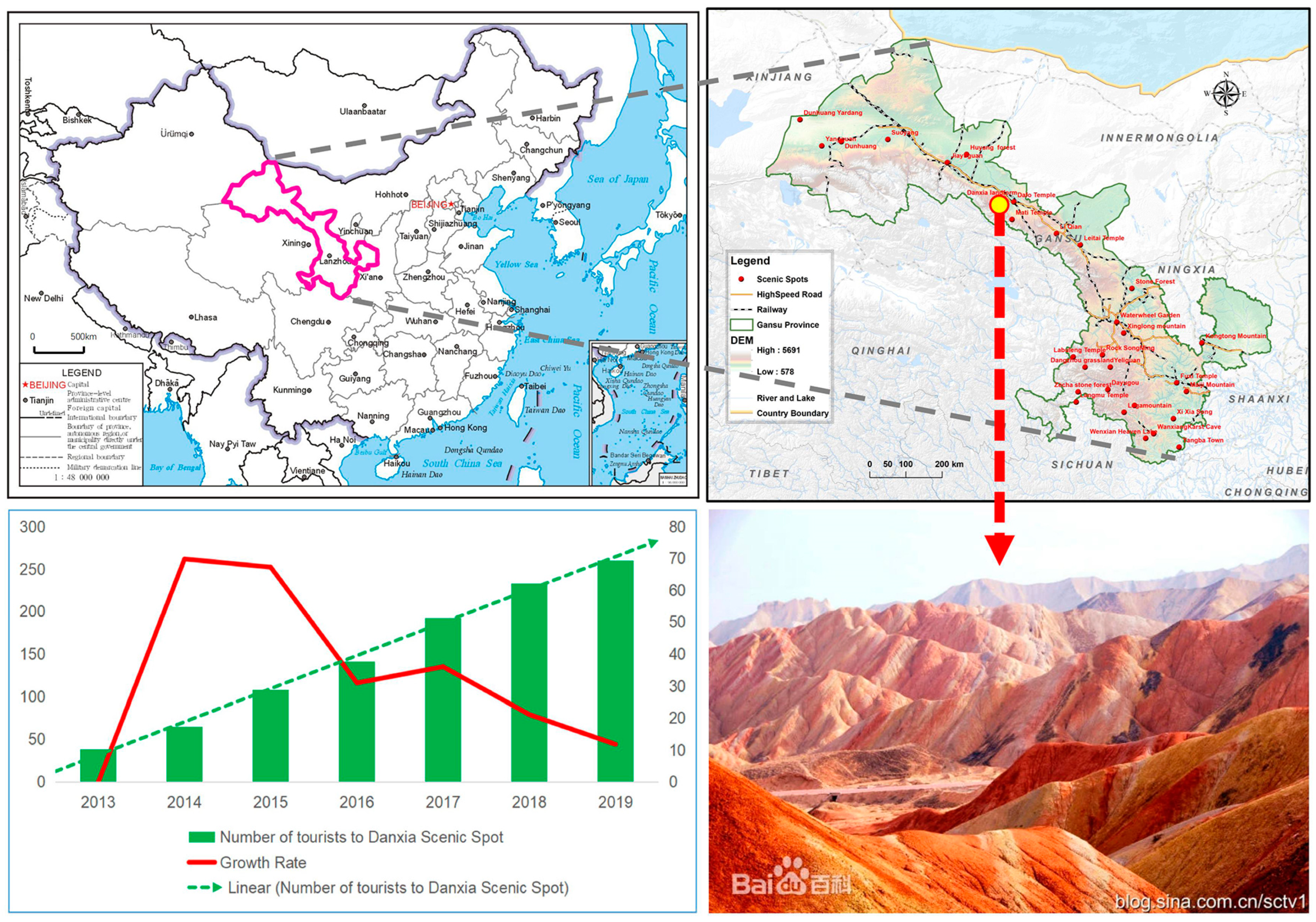
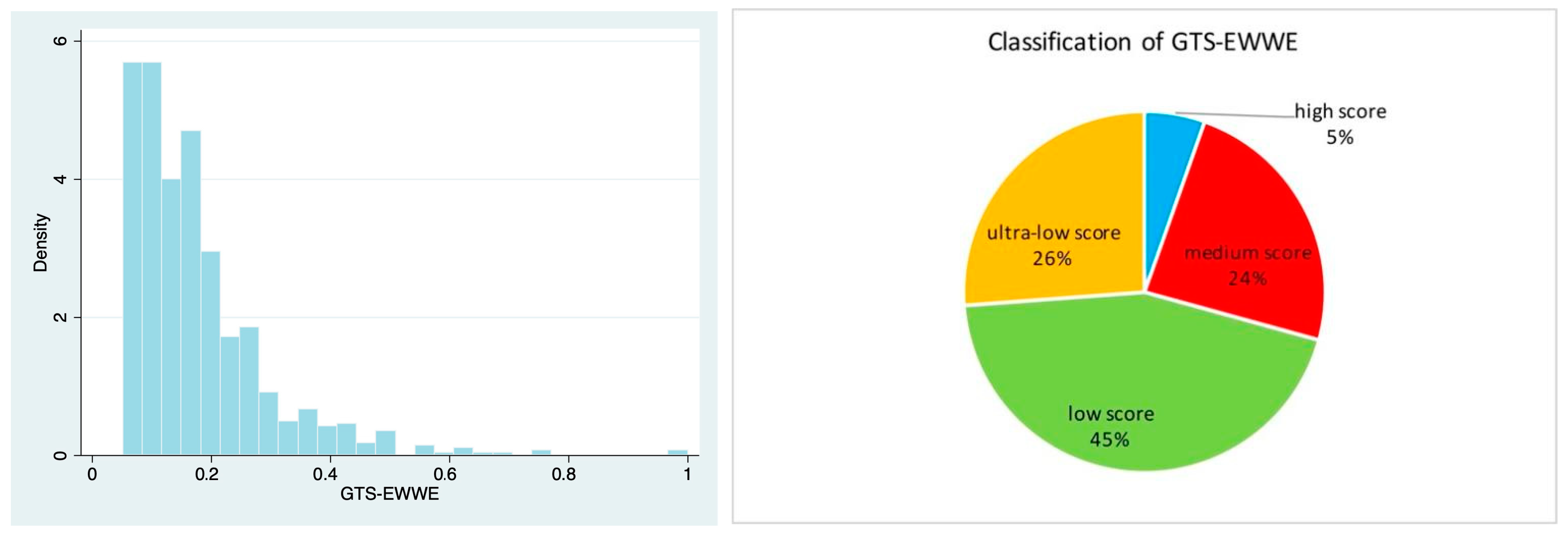
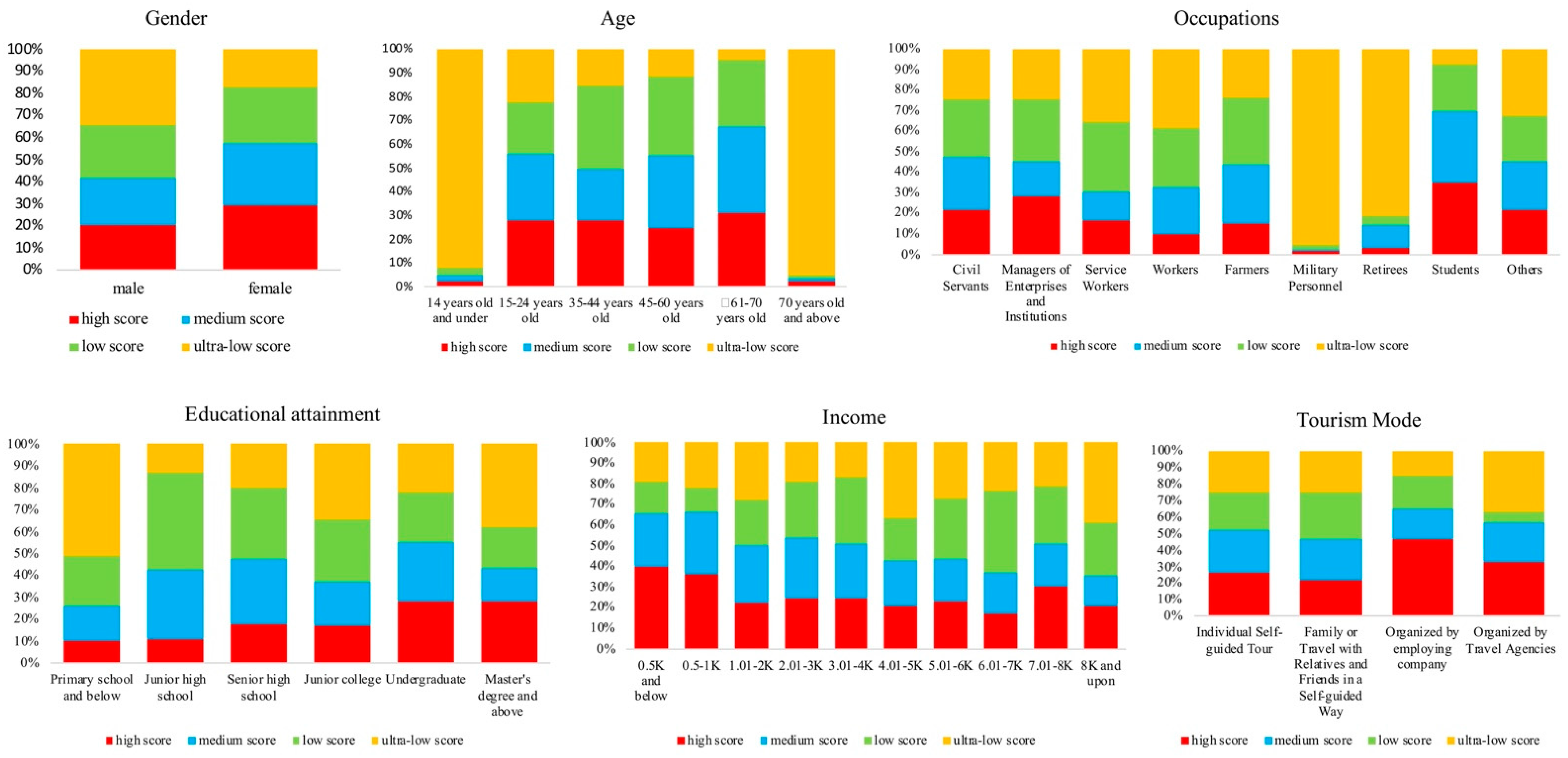
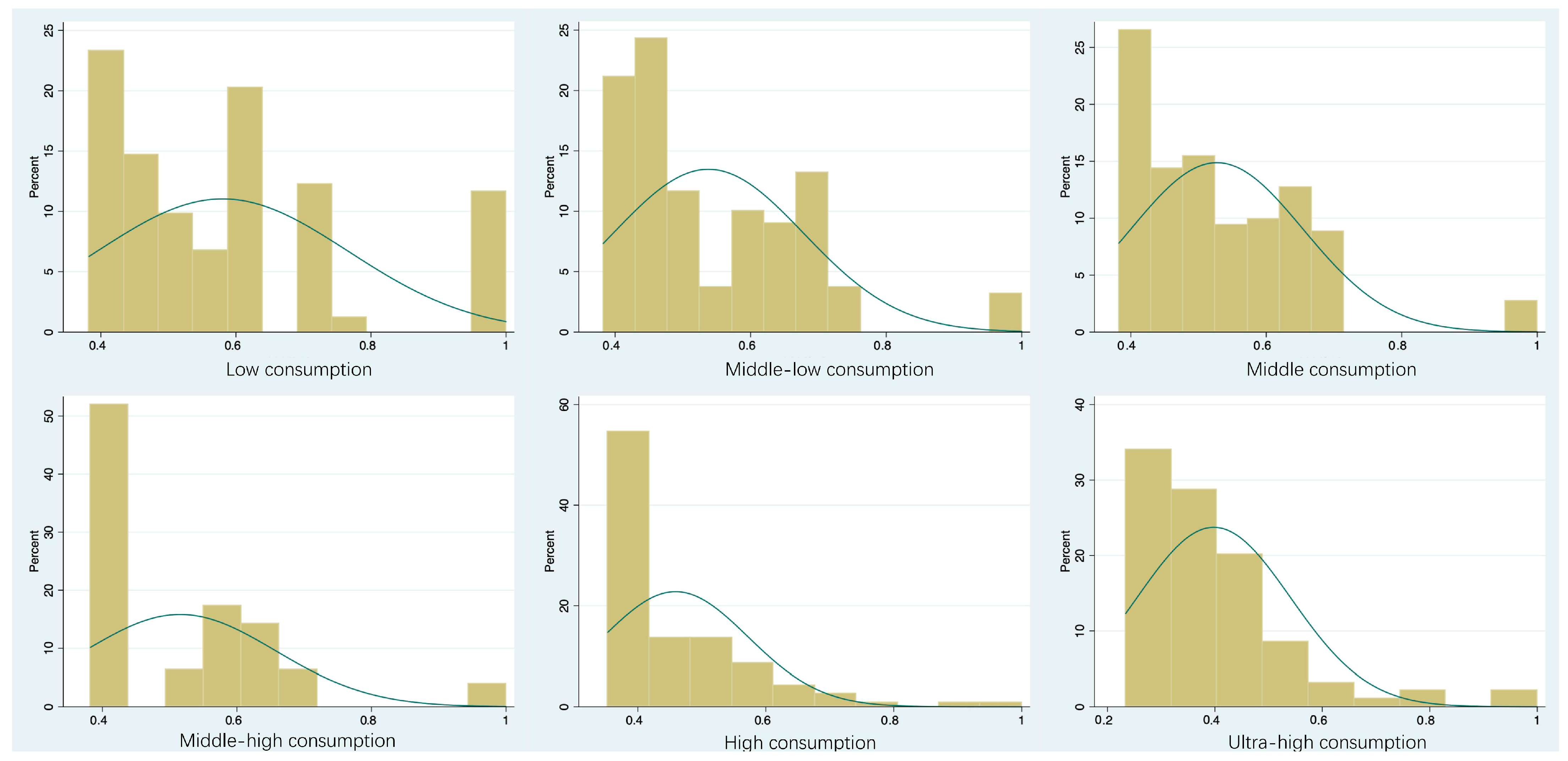
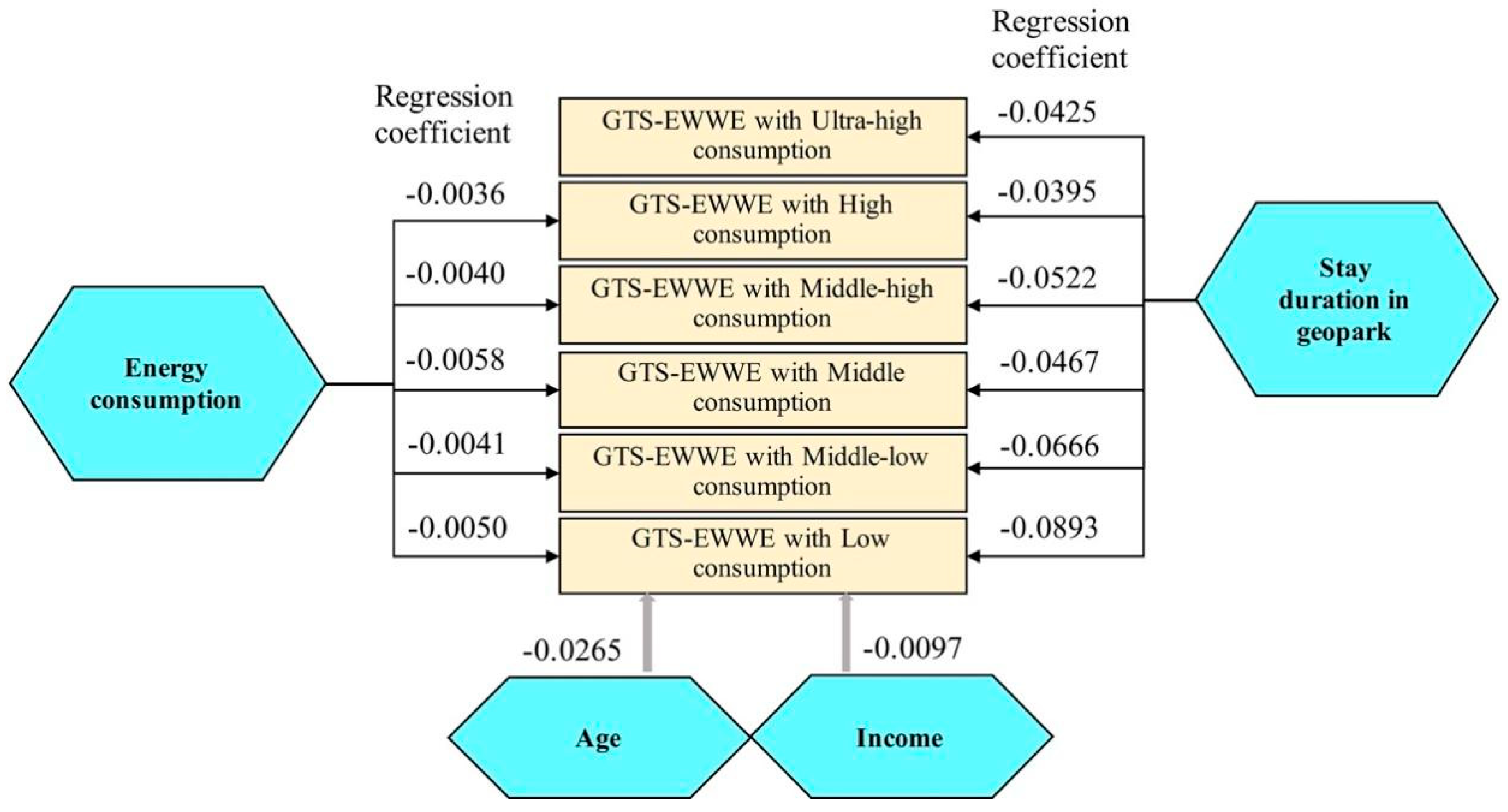
| Category | Category Features | Frequency | Rate (%) |
|---|---|---|---|
| Gender | male | 364 | 41.79 |
| female | 507 | 58.21 | |
| Age | 14 years old and under | 9 | 1.03 |
| 15–24 years old | 404 | 46.33 | |
| 25–34 years old | 231 | 26.50 | |
| 35–44 years old | 96 | 11.01 | |
| 45–60 years old | 126 | 14.45 | |
| 61–70 years old | 3 | 0.34 | |
| 70 years old and above | 3 | 0.34 | |
| Occupations | Civil servants | 95 | 10.91 |
| Managers of enterprises and institutions | 158 | 18.14 | |
| Service workers | 53 | 6.08 | |
| Workers | 41 | 4.71 | |
| Farmers | 20 | 2.30 | |
| Military personnel | 3 | 0.34 | |
| Retirees | 17 | 1.95 | |
| Students | 364 | 41.79 | |
| Others | 120 | 13.78 | |
| Educational attainment | Primary school and below | 13 | 1.49 |
| Junior high school | 40 | 4.59 | |
| Senior high school | 75 | 8.61 | |
| Junior college | 106 | 12.17 | |
| Undergraduate | 586 | 67.28 | |
| Master’s degree and above | 51 | 5.86 | |
| Income | CNY 0.5k and below | 51 | 5.86 |
| CNY 0.5k–1k | 92 | 10.56 | |
| CNY 1.01k–2k | 118 | 13.55 | |
| CNY 2.01k–3k | 181 | 20.78 | |
| CNY 3.01k–4k | 149 | 17.11 | |
| CNY 4.01k–5k | 89 | 10.22 | |
| CNY 5.01k–6K | 64 | 7.35 | |
| CNY 6.01k–7k | 38 | 4.36 | |
| CNY 7.01k–8k | 22 | 2.53 | |
| CNY 8k and upon | 67 | 7.69 | |
| Tourism Mode | Individual self-guided tour | 369 | 42.37 |
| Family or travel with relatives and friends in a self-guided way | 436 | 50.06 | |
| Organized by employing company | 32 | 3.67 | |
| Organized by Travel Agencies | 34 | 3.90 |
| Indicators | Data Source | Unit | |
|---|---|---|---|
| Input | Tourism Consumption Labor Input | Labor force/Tourist population | Person |
| Tourism Consumption Capital Input | Capital investment/Tourist population | Yuan | |
| Tourism Consumption Energy Input | Tourism activity energy consumption × project per capita energy consumption | Ton of Standard Coal | |
| Tourism Consumption Water Resource Input | Tourist stay duration × (Annual total water consumption/Tourist population)/Per capita tourist stay duration | Ton | |
| Output | Tourism Consumption Revenue | Ticket + Other expenses for travel | Yuan |
| Undesirable-output | Tourism Consumption Waste Emission | Tourist stay duration × (Total amount of waste discharge/Number of tourists)/Per capita tourist stay duration | Ton |
| Number | Relevant Factors | Correlation Coefficient | Number | Relevant Factors | Correlation Coefficient |
|---|---|---|---|---|---|
| 1 | Gender (GEN) | −0.1103 * | 8 | Energy Consumption (ENERGY) | −0.1741 * |
| 2 | Age (AGE) | 0.0125 | 9 | Water Consumption (WATE) | −0.1052 * |
| 3 | Educational Attainment (EDU) | −0.0942 * | 10 | Waste Discharge (WAST) | −0.1052 * |
| 4 | Income (INCO) | 0.1183 * | 11 | Cognition of Green Tourism (COGN) | 0.0886 * |
| 5 | Stay Time near the Park (STAYNE) | 0.1848 * | 11 | Supportive Attitude towards Green Tourism (SUPP) | 0.0181 |
| 6 | Stay Time in the Park (STAYIN) | −0.1052 * | 13 | Willingness to Pay for Green Tourism (WILL) | 0.1481 * |
| 7 | Expenditure (EXPE) | 0.8181 * |
| EWWE Sustainability | High-Score EWWE Sustainability | Medium-Score EWWE Sustainability | Low-Score EWWE Sustainability | Ultra-Low-Score EWWE Sustainability | ||||||
|---|---|---|---|---|---|---|---|---|---|---|
| Coef. | t | Coef. | t | Coef. | t | Coef. | t | Coef. | t | |
| GEN | 0.0001 | 0.0300 | −0.0485 | −1.6000 | 0.0178 | 3.2300 *** | 0.0008 | 0.3400 | −0.0018 | −1.4800 |
| EDU | −0.0027 | −1.4000 | −0.0251 | −2.1200 ** | 0.0002 | 0.0900 | −0.0007 | −0.5600 | 0.0002 | 0.2200 |
| INCO | −0.0005 | −0.6400 | −0.0003 | −0.0400 | 0.0004 | 0.3300 | −0.0002 | −0.4400 | −0.0008 | −3.0300 *** |
| STAYNE | 0.0008 | 0.4800 | 0.0043 | 0.5100 | 0.0017 | 0.8100 | 0.0010 | 1.0400 | 0.0005 | 0.7400 |
| STAYIN | −0.0261 | −18.8600 *** | −0.0843 | −7.9000 *** | −0.0184 | −9.0400 *** | −0.0114 | −11.1700 *** | −0.0051 | −10.2800 *** |
| COGN | −0.0024 | −1.2300 | −0.0074 | −0.6900 | −0.0005 | −0.1600 | −0.0016 | −1.2800 | −0.0001 | −0.2300 |
| WILL | 0.0023 | 1.5500 | −0.0105 | −1.1900 | −0.0016 | −0.8100 | 0.0008 | 0.8800 | −0.0004 | −0.8100 |
| ENERGY | −0.0013 | −5.5700 *** | −0.0051 | −4.2700 *** | −0.0008 | −2.3600 ** | −0.0006 | −3.5700 *** | −0.0002 | −2.8000 *** |
| LNEXPE | 0.1528 | 50.0200 *** | 0.2580 | 7.1300 *** | 0.0974 | 11.6700 *** | 0.0589 | 14.3900 *** | 0.0380 | 12.8400 *** |
| _cons | −0.5529 | −25.8200 | −0.7653 | −3.1600 | −0.2859 | −5.8600 | −0.1263 | −6.0300 | −0.0787 | −5.2300 |
| Log likelihood | 1282.1751 | 47.0777 | 389.9666 | 922.8448 | 760.7348 | |||||
| Group | Expenditure | Population | Percentage of Population | Statistical Characteristics of GTS-EWWE | |||
|---|---|---|---|---|---|---|---|
| Mean | Standard Deviation | Minimum | Maximum | ||||
| Low consumption | Less than 50 yuan | 163 | 18.714 | 0.5803 | 0.1861 | 0.3824 | 1.0000 |
| Medium-low consumption | 50–100 yuan | 189 | 21.699 | 0.5376 | 0.1407 | 0.3824 | 1.0000 |
| Medium consumption | 100–200 yuan | 181 | 20.781 | 0.5271 | 0.1274 | 0.3824 | 1.0000 |
| Medium-high consumption | 200–300 yuan | 127 | 14.581 | 0.5157 | 0.1416 | 0.3824 | 1.0000 |
| High consumption | 300–500 yuan | 117 | 13.433 | 0.4590 | 0.1132 | 0.3530 | 1.0000 |
| Ultra-high consumption | More than 500 yuan | 94 | 10.792 | 0.3979 | 0.1431 | 0.2338 | 1.0000 |
| Correlation Factors | GTS-EWWE with Low Consumption | GTS-EWWE with Medium-Low Consumption | GTS-EWWE with Medium Consumption | GTS-EWWE with Medium-High Consumption | GTS-EWWE with High-Consumption | GTS-EWWE with Ultra-High Consumption |
|---|---|---|---|---|---|---|
| GEN | −0.1463 | 0.0438 | 0.033 | 0.0452 | −0.1221 | −0.1243 |
| AGE | −0.1737 * | −0.0078 | 0.0249 | −0.0438 | −0.0861 | 0.0911 |
| EDU | −0.1806 * | −0.1324 | 0.0428 | 0.007 | −0.0426 | −0.0122 |
| INCO | −0.2398 * | −0.1315 | 0.0148 | 0.0831 | −0.1604 | 0.003 |
| STAYNE | −0.0489 | 0.0469 | −0.0973 | −0.0544 | −0.1256 | −0.0812 |
| STAYIN | −0.7015 * | −0.6011 * | −0.4766 * | −0.5796 * | −0.4881 * | −0.4484 * |
| ENERGY | −0.2180 * | −0.2225 * | −0.3313 * | −0.3796 * | −0.2762 * | −0.0659 |
| WATE | −0.7015 * | −0.6011 * | −0.4766 * | −0.5796 * | −0.4881 * | −0.4484 * |
| WAST | −0.7015 * | −0.6011 * | −0.4766 * | −0.5796 * | −0.4881 * | −0.4484 * |
| COGN | 0.0443 | −0.0253 | 0.1377 | −0.0565 | 0.075 | −0.0465 |
| SUPP | 0.0198 | −0.0594 | −0.0293 | 0.1854 * | −0.0314 | 0.0115 |
| WILL | −0.0714 | 0.0126 | −0.1585 * | −0.1421 | −0.0134 | 0.1042 |
| Indictor | GTS-EWWE with Low Consumption | GTS-EWWE with Medium-Low Consumption | GTS-EWWE with Medium Consumption | GTS-EWWE with Medium-High Consumption | GTS-EWWE with High-Consumption | GTS-EWWE with Ultra-High Consumption | ||||||
|---|---|---|---|---|---|---|---|---|---|---|---|---|
| Coef. | t | Coef. | t | Coef. | t | Coef. | t | Coef. | t | Coef. | t | |
| AGE | −0.0265 | −2.3500 ** | ||||||||||
| EDU | −0.0206 | −1.5100 | ||||||||||
| INCOME | −0.0097 | −1.9600 ** | ||||||||||
| STAYIN | −0.0893 | −11.5200 *** | −0.0666 | −10.4400 *** | −0.0467 | −7.5600 *** | −0.0522 | −6.8200 *** | −0.0395 | −6.4500 *** | −0.0425 | −4.8400 *** |
| ENERGY | −0.0050 | −2.7700 *** | −0.0041 | −3.5400 *** | −0.0058 | −4.9500 *** | −0.0040 | −3.1100 *** | −0.0036 | −3.7100 *** | ||
| SUPP | 0.0163 | 0.9000 | ||||||||||
| WILL | −0.0071 | −1.0300 | ||||||||||
| _cons | 1.0978 | 14.5600 | 0.7609 | 34.5900 | 0.7271 | 26.0500 | 0.7086 | 16.3000 | 0.6395 | 23.8100 | 0.5691 | 15.0800 |
| Log likelihood | 58.9295 | 131.6721 | 131.6721 | 83.4699 | 108.0056 | 53.5054 | ||||||
Disclaimer/Publisher’s Note: The statements, opinions and data contained in all publications are solely those of the individual author(s) and contributor(s) and not of MDPI and/or the editor(s). MDPI and/or the editor(s) disclaim responsibility for any injury to people or property resulting from any ideas, methods, instructions or products referred to in the content. |
© 2024 by the author. Licensee MDPI, Basel, Switzerland. This article is an open access article distributed under the terms and conditions of the Creative Commons Attribution (CC BY) license (https://creativecommons.org/licenses/by/4.0/).
Share and Cite
Xia, B. Sustainability Assessment of Geotourism Consumption Based on Energy–Water–Waste–Economic Nexus: Evidence from Zhangye Danxia National Geopark. Land 2024, 13, 1857. https://doi.org/10.3390/land13111857
Xia B. Sustainability Assessment of Geotourism Consumption Based on Energy–Water–Waste–Economic Nexus: Evidence from Zhangye Danxia National Geopark. Land. 2024; 13(11):1857. https://doi.org/10.3390/land13111857
Chicago/Turabian StyleXia, Bing. 2024. "Sustainability Assessment of Geotourism Consumption Based on Energy–Water–Waste–Economic Nexus: Evidence from Zhangye Danxia National Geopark" Land 13, no. 11: 1857. https://doi.org/10.3390/land13111857
APA StyleXia, B. (2024). Sustainability Assessment of Geotourism Consumption Based on Energy–Water–Waste–Economic Nexus: Evidence from Zhangye Danxia National Geopark. Land, 13(11), 1857. https://doi.org/10.3390/land13111857








